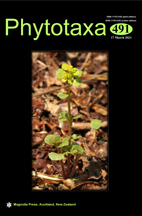Abstract
Phenakospermum guyannense is the only native species of Strelitziaceae in South America and occurs in the Amazon domain in Bolivia, Brazil, Colombia, Ecuador, French Guiana, Guyana, Peru, Suriname and Venezuela. The species presents a negative sampling bias, probably due to the great effort necessary to collect it, as it presents long leaves and coriaceous bracts. In the course of the studies for the monograph of Strelitziaceae for Flora do Brasil 2020 project and with an increase in plant collecting in Maranhão state, Brazil, we have detected two necessary adjustments to the knowledge of the species: 1) lectotypification of the basionym Urania guyannensis described by L.C.M. Richard and 2) reevaluation of the geographic distribution of the species, highlighting new records for the Brazilian Northeast region. Both issues are addressed here. Additionally, we present a description, a preliminary conservation status, a distribution map and notes on the ecology of the species.

